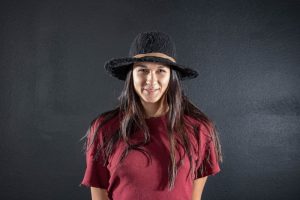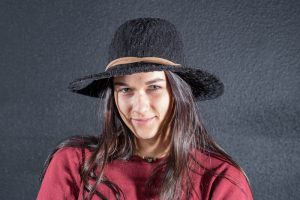Tags
Related Posts
Share This
CWL Senior Brantlee Reid

Brantlee Reid graduates from SFUAD in December. Photo by Chris Dorantes
Jackalope Magazine continues talking to senior Creative Writing and Literature students at Santa Fe University of Art and Design. Brantlee Reid has been published in, and served as an editor of, Glyph, SFUAD’s annual literary magazine. She is also founder and editor of Blood Tree Literature, a local literary journal. She talks about her senior book, major themes in her writing and plans for the future.
Jackalope Magazine: Can you tell us about your senior book?
Brantlee Reid: My senior book, tentatively titled The Shade Our Bodies Make, is a collection of flash fiction, nonfiction and hybrid pieces that are threaded by the butterfly effects of human nature. Inherited addictions, cycles of behavior, the loss of innocence; the way in which one experience can influence all others. There are also pieces that speak to the detriments of governmental subservience and the indirect impact that has on relationships.
I’m discovering more about my collection as I go through the revision process. I’m finding other threads I hadn’t noticed or emphasized before, such as the undesirability of motherhood, and have conceptualized a book much larger than this one that I will attempt to bring to fruition post-grad. What intrigues me most about putting together a book is the physical design and how textures and pages can be manipulated to create something zine-like in novel form, which would be something to consider as I pursue a final draft.
Have you always written about these themes?
My family tends to request that I write about uplifting subjects, not only misunderstanding me as a person altogether, but also misinterpreting the art of literature. We write what intrigues us, scares us, what we grapple with, what we know or want to know, what we can’t tear our thoughts away from. Since my freshman year, I have consistently written about oppression in one way or another. Only now it is centralized on that of the government due to a severe and ever-growing distrust in politicians, especially those on the higher pedestals. My first stories I’d ever written also involved body horror and gore like what will be seen in The Shade Our Bodies Make, but under subtler and more refined terms. Sorry, mom.
Have you noticed your writing change since you’ve been at SFUAD?
In terms of voice, yes. It wasn’t until my junior year that I felt like I had finally inhabited a voice that was entirely my own and not influenced by what I thought good writing should sound like. It was that year that I began to actually finish pieces instead of writing myself into a wall. In terms of process, I wish. My writing comes along tediously and is only expedited by impending deadlines.
What genres do you work in?
I tend to blanket my pieces under the ‘hybrid’ genre, giving my nonfiction stories more leniency to deviate off course, and allowing my fiction stories more veracity through the peppering-in of nonfiction, blurring the line of real and imagined.

Brantlee Reid is founder and editor of Blood Tree Literature. Photo by Chris Dorantes
What do you like reading?
My favorite thing I’ve read this semester has been There Will Come Soft Rains, a short sci-fi story by Ray Bradbury. Since being in Michael [Wilson]’s sci-fi class, I’ve taken interest in books that theorize the dilapidation of earth. Because sci-fi is largely prophetic, I read someone like H.G. Wells as more of a cautionary tale rather than a simple piece of fiction.
Where are you from? How do you end up in Santa Fe?
Sadly, I’m from a suburb of Dallas. It was my mom who found SFUAD online after a discussion my dad and I had over the things I might want to pursue yielded art as the denominator. I wasn’t interested at first, thinking New Mexico only amounted to sand dunes and sun and cacti, but instantly fell in love at first sight of the mountains. So, here I am.
Can you tell me about Blood Tree Literature?
While working with Glyph, I was more often than not in the minority when voting on pieces and cover designs, and I realized that I could use the tools from Glyph to engender something more visually and emotionally attractive to me. So a vision of my own journal began to shape. Simply and shamelessly, part of it was that I wanted to be the main authority in making editorial decisions, but I also imagined the opportunities afforded through digital publishing that would not be an option through print, such as the implementation of visual art like short films and audio accompaniment, things that would create a more interactive experience for the viewer.
If you had to pick one SFUAD class that has impacted you the most, which would it be? Why?
Any class is only as successful as its professor, and Julia Goldberg and Anne Valente were (and are) undoubtedly the best part of my time here at SFUAD. I’ve never seen teachers more prepared, engaged, caring and passionate about teaching us as those two. And their ability and willingness to go above and beyond their job description is endearing, and now I’m crying. But seriously, I have felt so supported and humbled by Anne and Julia, and, despite knowing the school’s impending closure, would choose SFUAD all over again if only to be mentored by them.
What do you plan on doing after graduation?
I’m going to stick around Santa Fe and work on completing two collections: a visual art collection of alchemized skulls, and the final and unpacked version of The Shade Our Bodies Make. My vision is to curate an art show with others around this time next year that showcases literature and visual art, an attempt I am making digitally with Blood Tree Literature. In the meantime, my partner and I are building out a 1988 van to travel the Americas and Canada come 2019.
This interview has been edited for style and clarity.






 Jackalope Magazine is the student magazine of Santa Fe University of Art and Design. Building on the interdisciplinary nature of our education, we aim to showcase the talent of our university and character of our city.
Jackalope Magazine is the student magazine of Santa Fe University of Art and Design. Building on the interdisciplinary nature of our education, we aim to showcase the talent of our university and character of our city.
0 Comments
Trackbacks/Pingbacks